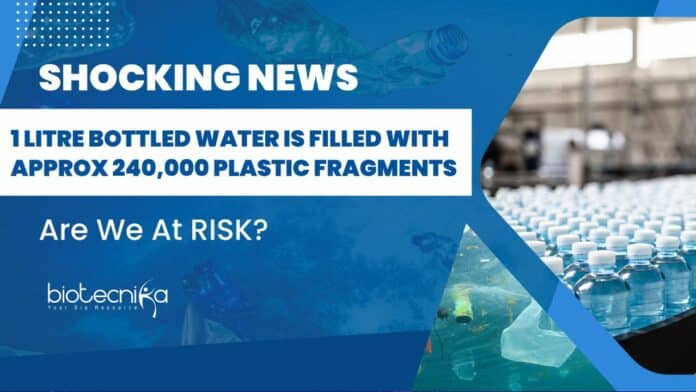240000 Approx Plastic Fragments Found in Drinking Water – The Hidden Dangers of Bottled Water: Unveiling the Shocking Truth About Plastic Fragments
A recent study has revealed groundbreaking findings about the hidden dangers of bottled water. The research indicates that a typical one-liter bottle of water contains approximately 240,000 plastic fragments, with many of them being “nanoplastics” – particles smaller than 1 micrometer in length. These nanoparticles pose a greater threat to human health than larger microplastics due to their ability to penetrate cells, enter the bloodstream, and impact organs. This article aims to shed light on this concerning issue, emphasizing the need for awareness and action to mitigate the risks associated with plastic pollution in water.
The Extent of Plastic Pollution in Bottled Water:
Previous studies only accounted for microplastics, which are pieces between 1 and 5,000 micrometers in size. However, the recent study evaluated the presence of nanoplastics in bottled water for the first time. The findings demonstrate that bottled water can contain up to 100 times more plastic particles than previously estimated, suggesting that health concerns related to plastic pollution may have been significantly underestimated.
Understanding Nanoplastics and Their Effects on Health:
Unlike microplastics, which are larger
and less likely to enter human cells, nanoplastics can easily penetrate cells, enter the bloodstream, and even impact organs. This makes them a more significant threat to human health. Additionally, nanoplastics can cross the placenta, potentially affecting unborn babies. The study reveals that previous knowledge about nanoplastics was limited due to the lack of technology to identify these individual particles. However, the researchers used a new microscopy technique and data-driven algorithm to analyze water samples from popular brands in the US, discovering a high concentration of nanoplastics.Identification of Nanoplastics in Bottled Water:
The study focused on seven common plastic types, including polyethylene terephthalate (PET), commonly used in water bottles, and polyamide, often found in water filtration systems. However, researchers also found numerous unidentified nanoparticles, which may further increase the prevalence of plastic in bottled water. This highlights the urgent need for further studies to explore the extent of nanoplastic contamination and identify potential health risks associated with these particles.
The Environmental Impact of Plastic Pollution:
The production of plastics worldwide exceeds 450 million tons annually, a significant portion of which accumulates in landfills. Plastic does not naturally degrade but breaks down into smaller fragments over time. Various plastic-containing products, including synthetic fabrics, routinely shed tiny plastic particles during use. Although plastic pollution exists across the planet, the focus on bottled water arises from the potential of introducing plastic particles directly into the human body. Studies comparing bottled water and tap water have shown a higher concentration of microplastics in bottled water, demonstrating the need for comprehensive analysis and regulation in the industry.
Implications and Future Research:
The implications of the study extend beyond bottled water. The researchers intend to investigate the presence of nanoplastics in tap water and collect snow samples from western Antarctica. By doing so, they aim to expand the understanding of nanoplastics’ prevalence and their impact on ecosystems as well as human health. It is clear that more extensive research is necessary to address the challenges posed by nanoplastics and develop effective strategies to combat plastic pollution.
The revelation that a one-liter bottle of water contains an alarming number of plastic fragments, particularly nanoplastics, highlights the gravity of plastic pollution in our daily lives. Not only does this contamination pose a significant risk to human health, but it also threatens the environment. Further research is needed to explore the extent of plastic pollution in various water sources and develop preventive measures to eliminate or minimize the impact of nanoplastics. Increased awareness, coupled with individual and collective efforts, can contribute to a healthier and cleaner future for our planet.
Keywords: 240000 Plastic Fragments, bottled water, plastic pollution, nanoplastics, health risks, human cells, microplastics, water contamination, environmental impact, plastic fragments, plastic particles, plastic pollution in water.



























